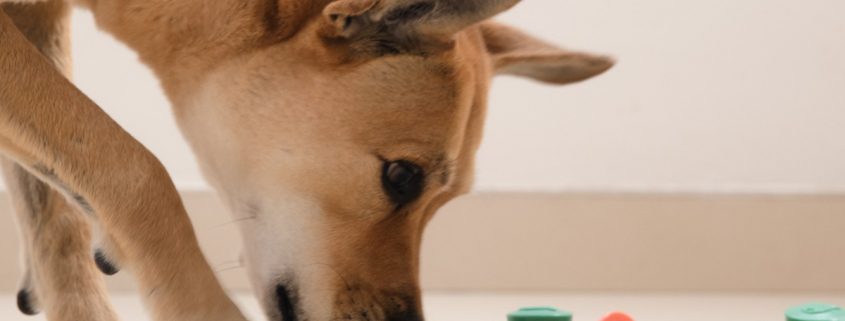Generations ago, domesticated dogs led active lifestyles and had working roles within the household, including guarding property, protecting livestock, and chasing vermin. Our modern lifestyle has evolved more quickly than our dogs’ instincts and the once desirable behaviors bred into our dogs to make them good workers are no longer used.
Dogs that don’t have enough opportunities to express their positive, natural behaviors may instead exhibit repetitive, stereotypic behaviors, including excessive licking, pacing and circling, eating non-food items, destroying objects, repetitive barking and more. These behaviors are performed to occupy the dog’s time in a boring environment.
The good news is these behaviors can be overcome through enrichment, which increases the complexity of the environment, gives the animal a bit of control, and allows them to display more healthy, natural behaviors. Enrichment should be biologically relevant to the intended species, which for dogs means activities and objects that engage them in playing, chasing, retrieving, chewing, sniffing and scavenging.
Below you will find several boredom busters for dogs that are easy to implement and fun for canines of all ages.
Engage the body
Yes, it’s true…a tired dog is a happy dog! To help bust boredom, make sure you’re setting aside time every day to play with your furry best friend. This playtime should be separate from potty walks and should incorporate activities and toys your dog gets excited about. Here are some ideas:
- Head outside for a fast-paced game of fetch, tug or frisbee to get your pup moving and to work on their retrieving skills
- Venture out on a “sniff walk” in which your dog determines the pace and is allowed to stop and sniff anything and everything that catches their nose.
- Build a backyard obstacle course out of items you have on hand (shipping boxes, hula hoop, baby pool, flower pots) and teach your dog to run the course.
- If indoor exercise is more your speed, try a living room obstacle course, run your dog up and down a set of carpeted stairs, or start a rousing game of rope toy tug.
Choose activities appropriate to your dog’s breed, age and fitness level. A tiny Yorkie or a short-legged Corgi won’t be able to play as vigorously or for as long as a border collie or a Labrador retriever. But if you choose the right activity, your dog will have the time of their life and will need a long nap when you’re done!
Stimulate the mind
Giving your dog’s brain a workout is just as important as exercising their body. Challenge your dog intellectually with interactive games and puzzles that can be purchased from your local pet store or made as a fun DIY project. Dogs especially enjoy food puzzles and treat-dispensing snuffle mats loaded with high-value treats that will keep them busy and engaged. An old toy your dog hasn’t seen in some time can also be exciting. Try rotating toys in and out of their toybox to keep things fresh. If you have a particularly trainable dog, you can work on new commands, teach them to hunt for hidden objects, or teach them a specific job such as bringing you their leash before walks or picking up their toys and placing them in the toybox. Engaging their brain with boredom busters will keep them happy, with the added benefit of wearing them out.
Hang with friends
Socialization isn’t only for puppies! Adult dogs can also benefit from interactions with new people, animals and places. If your dog is social by nature, be open to the possibility of meeting new neighbors and their canine companions while out on walks. A dog that takes a little longer to warm up to strangers may benefit from a doggie playdate with a known human friend and their dog instead. If you truly want to give your dog a heap of social interaction and active play, consider enrolling them in a local doggy daycare once or twice a week. This will be the perfect environment for them to practice natural dog behaviors in a safe setting designed just for them!
By keeping your dog busy with these boredom busters and other appropriate enrichment activities when you’re together, you increase your dog’s chances for success when left alone. Your pup will be ready for a good long nap and you won’t have to worry about those destructive or repetitive behaviors that make you both miserable!
Your Pets are our Priority!
At the National Animal Supplement Council (NASC), our number one priority is to promote the health and wellbeing of your pets. That is why we created the NASC audit program and the Quality Seal, which helps you identify animal health and nutritional supplements that come from responsible suppliers committed to producing the highest quality, most consistent products available. Visit our website to learn more and to see a list of NASC members that have earned the Quality Seal.


